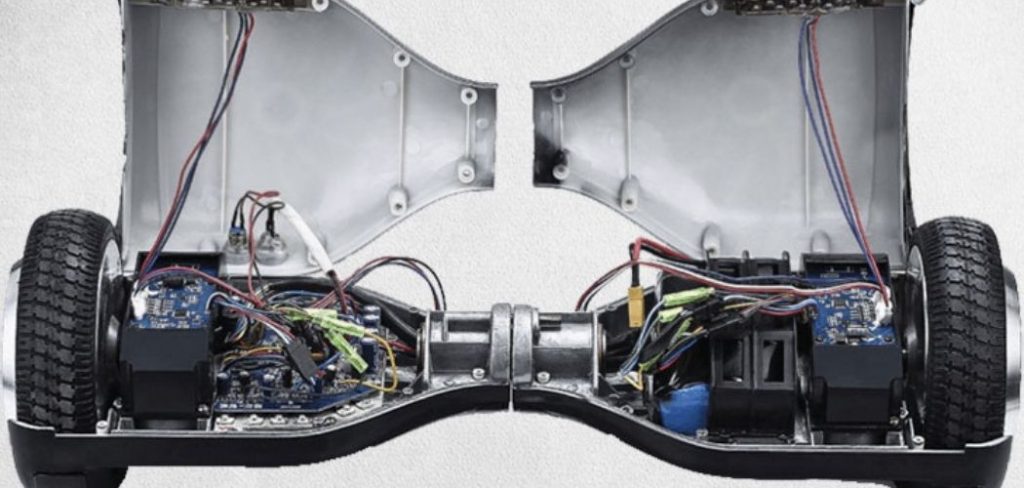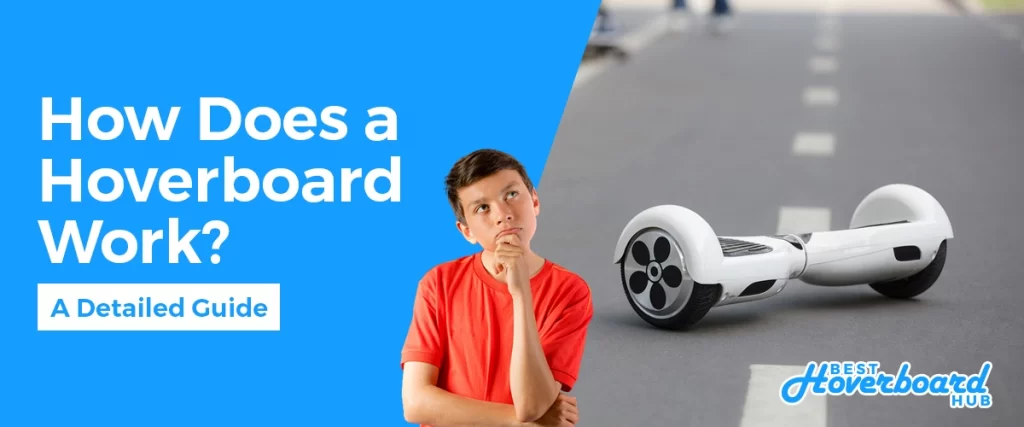This trendy self-balancing scooter has snatched many people’s attention due to its unique transportation ability, design, and structure. But have you ever wondered about the mechanism and technology behind the device and how does a hoverboard work flawlessly? Well, you are not alone as many people have asked this questions so many times.
I will tell you how hoverboards, a personal transport device, work and the various components and elements that make this function possible. Let’s dive deep into the mechanism of self-balancing scooters.
How Does a Hoverboard Work?
Contrary to what its name suggests, hoverboards do not “hover”; instead, they use batteries, wheels, sensors, pressure pads, and a combination of other elements to move a person from one place to another. Each component is assigned specific functions that they carry out to make moving around effortless. Therefore, before discussing how hoverboards work, you need to know their internal structure to understand how it operates.
Components That Make Hoverboard Movement Possible
Hoverboard is made up of several key elements that are as follows.

A hoverboard contain important components that actually run the hoverboards very smoothly. These are mentioned below.
Pressure Sensors
Pressure sensors are embedded in the foot pads that can sense your foot’s movement and direction and inform the logic board of your position. There are different sensors for each of your movements. For example, if you lean forward, one sensor is alerted, and if you lean backward, another sensor is alerted. They then work together to make the device’s movement possible.
Gyroscope
It’s a sensor that is necessary for maintaining balance on the self-balancing scooter and is present in each wheel. Due to its importance, the hoverboard is also referred to as a gyro-scooter. It operates by sensing any movements in the device’s direction, tilt, and rotation and then sends signals to the logic board, which adjusts its speed and direction accordingly.
In addition, it also calculates the hoverboard’s tilt angle through the movement of mass on the platform. Hence they can sense in which direction you are leaning, and they will transport you in that specific direction.
Side by side with the gyroscope, the hoverboards also use magnetometers to calculate the earth’s magnetic field using the Hall Effect principle and accelerometers to determine any shift in the acceleration of the device. In brief, the gyroscope and other sensors and elements work together to keep the hoverboard stable and balanced.
Logic Board
You can refer to it as the core of the device because it controls and monitors communication between the main components of a hoverboard. The circuit board receives information from various sensors and dispatches this data to the motors.
When you ride the self-balancing scooter, the logic board commands the motors, instructing them to move in a certain direction, speed up, or slow down. Some hoverboards have features that adjust your speed level. It is the logic board that performs this function and accommodates your speed level to suit different users’ needs.
What’s more, the logic board comprises of safety measures such as short-circuit and over-voltage protection that ensures the user’s and device’s safety. Hence offering you safe and secure transport.
Batteries
Well, you need something to power up your device; without it, you can’t ride your favorite hoverboard. Most hoverboards are driven by small and light yet powerful lithium-ion batteries, which are situated inside the frame and you can recharge the hoverboard battery using the hoverboard charger.
Furthermore, the battery discharge rate is slow compared to other batteries, meaning that even if you don’t use your device for a period of time, it will still retain its charge. Hence for a certain time, you don’t have to worry about a “dead battery.”
Motor
The device is equipped with two motors located on each of the wheels. The motor receives commands from the logic board and interprets that data to control and maintain the device’s speed, tilt, and balance.
How Do These Components Come Together To Create Movement?
Now let’s look at how these elements cooperate together to transport a person from one location to another smoothly.
When you step on the foot pads, the pads are pressed, triggering the sensors, which monitor the shift in your weight and send this information to the logic board, which in turn commands the motor to start moving.
How to Propel the Device in Different Directions?
It’s very simple, when you step on foot-pads the gyroscope alerts and informs the circuit board about the person’s position. It senses your weight distribution, so if you want to move ahead, lean toward the forward direction, but if you want to move backward, tilt toward the reverse direction.
After the logic board receives the data from the gyroscope, it commands the motors to propel in a certain direction and maintain balance. You can move in another direction by using this same logic. Do you want to move left? Then shift your weight slightly towards the left direction and, simultaneously, transfer your weight away from the right paddle. Follow the same direction if you want to move right.
Moreover, high-quality hoverboards are furnished with rubber grips on foot pads that will aid you in transporting easily without worrying about slipping off the device. Remember, when changing directions, put pressure on your heels and only move your feet in the desired direction, not your whole body. Because the gyroscope only senses your feet’ movements.
In addition, the sensors also monitor how much pressure you are applying to move in that specific direction which affects your acceleration and deceleration. If you apply too much pressure, the logic board will command the motor to speed up the device and vice versa.
How to Stop the Device?
If you want to stop, just simply stand still. When you stand still, you are not tilting toward any specific direction, so the pressure sensors send this information to the logic board. It then gives instructions to the monitor to stop the movements. Hence the device will not move in any direction.
How to Spin the Hoverboard?
Want to know how it feels when the hoverboard spins? It’s easy, tilt your right foot in the forward direction and your left foot in the backward direction, and the device will start spinning. Why does this happen? It’s because your weight is not evenly spread out on the platform, which disrupts the coordination of the sensors.
How Does Hoverboard Keep its Balance?
The hoverboard stays balanced due to the sensors (gyroscope, accelerometer, magnetometer, etc), which measure the tilt, speed, and direction of the person’s feet. Hence you can enjoy a smooth ride.
FAQs
How does the hoverboard know where to go?
When you step on the device and position your feet in a specific direction, the gyroscope senses this movement and sends a message to the logic board. The circuit board then commands the motor to move.
Does the hoverboard have any brakes?
No, the rider’s feet control the hoverboard movements.
Do hoverboard work on grass?
Yes, hoverboards can work grass as well but the grass should be shorter not taller to avoid damage. Read in detail about the hoverboard’s working on the grass.
To Sum it Up
Summing it up, a hoverboard is a personal transport device that uses different elements such as sensors, motors, and more to function smoothly. Each component is allocated a specific function that it needs to perform to maintain the device’s movement and balance.
The hoverboard works quite easily. All you need to be wary of is how much pressure you should apply on your feet which determines your speed. The gyroscope detects your feet’ movements, which sends a message to the logic board, instructing the motor to move accordingly. Easy, isn’t it?
Moreover, not all hoverboards function according to the techniques described in the article; there might be slight variations. Therefore, remember to read the user manual when you purchase a hoverboard.
